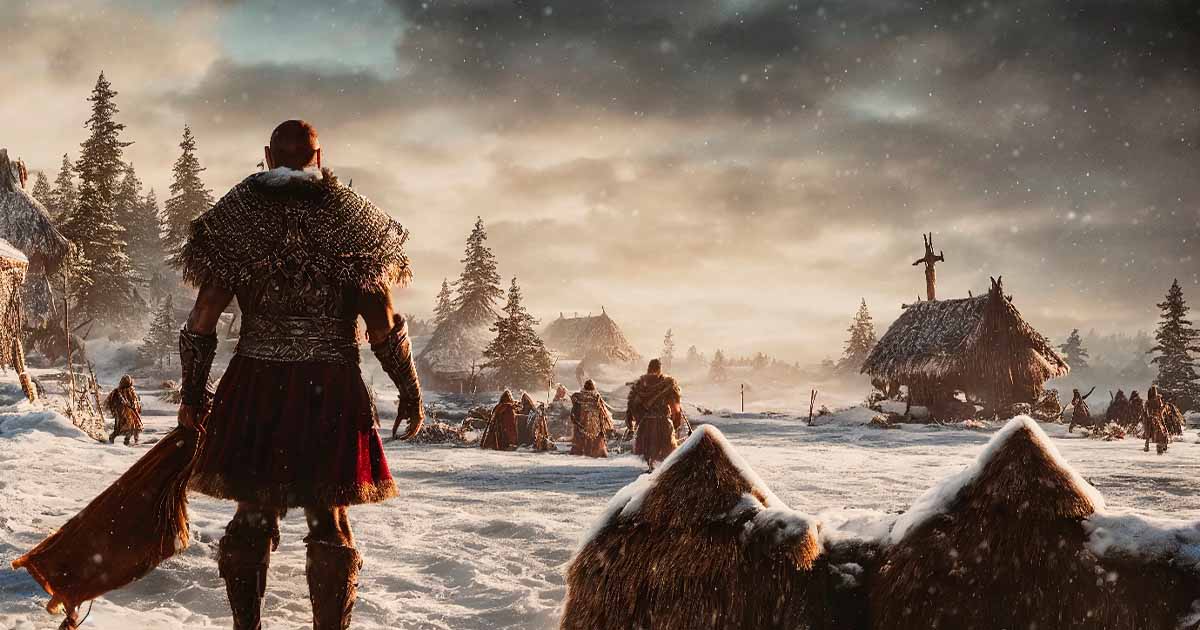How the Little Ice Age Caused Greenland Vikings to Jump Ship
A new study challenges previous ideas as to why Vikings abandoned their Greenland settlements. It found this northern exodus wasn’t sparked by political wrangling or social unrest, but by the Little Ice Age causing rising sea-levels.
Defined by great advances in Viking exploration, trade, and raiding across coastal Europe, the Viking Age began around 793 AD with the raid on the Lindisfarne monastery in England. In the North Atlantic, Viking settlers farmed on Greenland from between 985 AD to 1450 AD, before they suddenly vanished. Until now, the reason for the Vikings’ quick departure from Greenland has represented a perplexing historical mystery.
- Chilling battles: How Medieval Knights Fought in the Freezing Cold (Video)
- Beyond Violence: Examining UK Viking Families and their Artifacts
But now, a new study by a team from Harvard University’s Department of Earth and Planetary Sciences (EPS), published in the Proceedings of the National Academy of Sciences (PNAS), suggests “rising sea level” played a major role in the collapse of the Viking settlements on Greenland.
Reaching A Tidal Tipping Point
At the beginning of the 10th century, the Norse settlers in Greenland, who were descendants of the first Viking explorers, had established two primary settlements known as the Eastern Settlement and the Western Settlement. According to a report in Harvard Magazine, Marisa J. Borreggine, the lead author of the new paper, says many theories have been forwarded to account for the Vikings abandoning their settlements in Greenland.
According to Borreggine, until now, most historians have maintained the Greenland Vikings had “experienced social unrest, economic turmoil and political issues.” However, the researcher said that alongside these challenges, a rapidly changing environment likely led “to a tipping point” before the Vikings abandoned the settlement.
- History of the Vikings: All You Need to Know
- The Little Ice Age and Its Giant Impact on Human History
Nobody Saw the Little Ice Age Coming
The new study says the Viking’s abandonment of Greenland occurred in conjunction with the onset of the “Little Ice Age,” during which increased sea ice caused the climate in Greenland to become much colder, resulting in shorter growing seasons. This made it much more difficult for the Norse settlers to sustain their livelihoods through farming and oceanic trading.
Borreggine looked closely at previously published geomorphological and paleoclimate data, and compared this with glacial isostatic adjustment (GIA), the process by which the Earth's crust responds to changes in ice load during glacial periods. As the ice grows or melts, GIA affects the Earth’s gravitational field, and the axis of rotation and crustal deformation, said Borreggine.

Hiking path to the icefjord in Ilulissat, Greenland. (smallredgirl/Adobe Stock)
Kicked Out By A Double Whammy
GIA causes massive ice sheets to form, and the weight of the ice causes the underlying land to sink. Then, when the ice melts, the land rebounds causing changes in sea level which affects coastal regions. Borreggine said that for the “first time” the team were able to assess non-uniform sea-level change, allowing them to accurately gauge why exactly the Vikings abandoned the Eastern Settlement.
The Harvard University report describes the researchers’ findings as “striking.” They discovered that Greenland’s landmass was drawn up by gravity which made the Eastern settlement more prone to flooding. Also, crustal subsidence, (the sinking of land) was exacerbated by the gravitational pull of water toward the growing ice sheet. Borreggine said “Not only do you have the ground being pushed down, you also have the sea surface going up - “so It’s a double whammy.”
Salt Saturated Fields Forced The Vikings Out Of Greenland
The new study concludes that during the Little Ice Age the Greenland settlers endured up to 3.3 meters (10.82 ft) of sea-level rise. Putting this rise into context, Borreggine explained that this is “two to six times the rate of 20th-century sea-level rise,” which also caused extreme flooding in agricultural areas.
With the Little Ice Age causing their fields to become saturated with salt, Borreggine concluded that the Norse settlers on Greenland tried their best to adapt to the changing climate, but they could do nothing to stop it, which ultimately led to the abandonment of the island.
Top image: AI generated image of Greenland Vikings during extreme conditions of the Little Ice Age. Source: Jenar/Adobe Stock
By Ashley Cowie




















Comments
Mostly wrong. The Little Ice Age had nothing to do with the demolition of the Greenland settlement. Nor did climate change or global warming. What happened to Greenland was an economic catastrophe. Greenland in the 14th century was Europe’s only source of ivory. that was the reason why Scandinavian traders came to Greenland: for a luxury commodity.
However, the commercial world was changing. Increasing commerce with Africa was opening up new supplies of ivory from there. The much higher transport costs from Greenland could no longer be justified, particularly not when African ivory could be supplied in greater quantity at a lower price. As soon as ivory from Africa started to appear in Europe, Greenland started to die. It was all over in much less than two decades.
No one should be surprised at this. Europe and North America have produced hundreds of ghost towns and cities in the past two centuries, all for reasons of economic strangulation.
Core samples of human bones found in the digs should be DNA tested to confirm ethnicity and date of life/death. But oddly the focus is this (what they ate)? https://phys.org/news/2022-10-genetic-analysis-bones-greenland-early.html
Nobody gets paid to tell the truth.